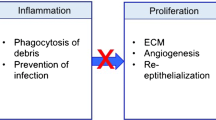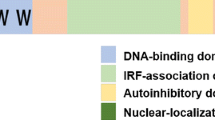Abstract
Peripheral blood fibrocytes are a novel population of cells that rapidly enter sites of tissue injury and contribute to connective scar formation. Fibrocytes display a distinct cell surface phenotype (CD34+/CD45+/collagen I+), and are an abundant source of cytokines and growth factors that function to attract and activate inflammatory and connective tissue cells. Fibrocytes also are specialized to activate naïve T cells against foreign antigen, and may play a critical role in the initiation of cognate immunity during the earliest phases of tissue injury. Recently, immunohistochemical studies of fibrotic tissues have shown that fibrocytes co-localize to areas of connective tissue matrix deposition. Peripheral blood fibrocytes thus may participate in the generation of excessive fibroses associated with various autoimmune disorders involving a persistent T-cell activation, as occurs in scleroderma.
Similar content being viewed by others
References and Recommended Reading
Wahl LM, Wahl SM: Inflammation. In In Wound Healing: Biochemical and Clinical Aspects. Edited by Cohen RF, Diegelman RF, Lindblad WJ. Philadelphia: WB Saunders; 1992:40–62.
Clark RAF: Wound repair: overview and general considerations. In The Molecular and Cellular Biology of Wound Repair. Edited by Clark RAF. New York: Plenum; 1996:3–35.
Rappolee DA, Mark D, Banda MJ, Werb Z: Wound macrophages express TGF-alpha and other growth factors in vivo: analysis by MRNA phenotyping. Science 1988, 241(4866):708–712.
Morgan CJ, Pledger WJ: Fibroblast proliferation. In Wound Healing. Edited by Cohen IK, Diegelman RF, Lindblad WJ. Philadelphia: WB Saunders; 1992:63–76.
Kovacs EJ, DiPietro LA: Fibrogenic cytokines and connective tissue production. FASEB J 1994, 8(11):854–861.
Paget J: Lectures on Surgical Pathology Delivered at the Royal College of Surgeons of England. In London: Longmans; 1863. 7. Dunphy J: The fibroblast—a ubiquitous ally for the surgeon. N Engl J Med 1963, 268:1367–1377.
Jackson DS: Specialized functions of connective tissue cells. In In The Biology of the Connective Tissue Cells. New York: Arthritis and Rheumatism Foundation; 1991:172–178.
Petrakis NL, Davis M, Lucia SP: In vivo differentiation of human leukocytes into histiocytes, fibroblasts, and fat cells in subcutaneous diffusion chambers. Blood 1961, 17:109–118.
Labat ML, Bringuier AF, Arys-Philippart C, et al.: Monocytic origin of fibrosis. In vitro transformation of HLA-DR monocytes into neo-fibroblasts: inhibitory effect of all-trans retinoic acid on this process. Biomed Pharmacother 1994, 48(2):103–111.
Bucala R, Spiegel LA, Chesney J, et al.: Circulating fibrocytes define a new leukocyte subpopulation that mediates tissue repair. Mol Med 1994, 1(1):71–81.
Diegelmann RF, Lindblad WJ, Cohen IK: A subcutaneous implant for wound healing studies in humans. J Surg Res 1986, 40(3):229–237.
Diegelmann RF, Kim JC, Lindblad WJ, et al.: Collection of leukocytes, fibroblasts, and collagen within an implantable reservoir tube during tissue repair. J Leukocyte Biol 1987, 42(6):667–672.
Freudenthal PS, Steinman RM: The distinct surface of human blood dendritic cells, as observed after an improved isolation method. Proc Natl Acad Sci USA 1990, 87(19):7698–7702.
Galy A, Travis M, Cen D, Chen B: Human T, B, natural killer, and dendritic cells arise from a common bone marrow progenitor cell subset. Immunity 1995, 3(4):459–473.
Barclay AN, Beyers AB, Birkeland ML, et al.: The Leukocyte Antigen Facts Book. New York: Academic Press; 1993.
Chesney J, Metz C, Stavitsky AB, et al.: Regulated production of Type I collagen and inflammatory cytokines by peripheral blood fibrocytes. J Immunol 1998, 160(1):419–425. This study led to the conclusion that fibrocytes are an important source of cytokines and type I collagen during both the inflammatory and the repair phase of the wound healing response.
Kishimoto T, Akira S, Taga T: Interleukin-6 and its receptor:a paradigm for cytokines. Science 1992, 258(5082):593–597.
Callard R, Gearing A: The Cytokine Facts Book. New York: Academic Press, 1994.
Ford HR, Hoffman RA, Wing EJ, et al.: Characterization of wound cytokines in the sponge matrix model. Arch Surg 1989, 124(12):1422–1428.
Mast BA: The skin. In Wound Healing: Biochemical and Clinical Aspects. Edited by Cohen IK, Diegelman RF, Lindblad WJ. Philadelphia: WB Saunders; 1992:344–355.
Chu T, Jaffe R: The normal Langerhans cell and the LCH cell. Br J Cancer Suppl 1994, 23:S4-S10.
Chesney J, Bacher M, Bender A, Bucala R: The peripheral blood fibrocyte is a potent antigen-presenting cell capable of priming naive T Cells in situ. Proc Natl Acad Sci USA 1997, 94(12):6307–6312.
Geppert TD, Lipsky PE: Antigen presentation by interferongamma-treated endothelial cells and fibroblasts: differential ability to function as antigen-presenting cells despite comparable Ia expression. J Immunol 1985, 135(6):3750–3762.
Pober JS, Gimbrone MA Jr, Cotran RS, et al.: Ia expression by vascular endothelium is inducible by activated T cells and by human gamma interferon. J Exp Med 1983, 157(4):1339–1353.
Le PooleIC, Mutis T, van den WijngaardRM, et al.: A novel, antigen-presenting function of melanocytes and its possible relationship to hypopigmentary disorders. J Immunol 1993, 151(12):7284–7292.
Inaba K, Metlay JP, Crowley MT, Steinman RM: Dendritic cells pulsed with protein antigens in vitro can prime antigenspecific, MHC-restricted T cells in situ. J Exp Med 1990, 172(2):631–640.
Levin D, Constant S, Pasqualini T, et al.: Role of dendritic cells in the priming of CD4+ T lymphocytes to peptide antigen in vivo. J Immunol 1993, 151(12):6742–6750.
Schall TJ, Bacon K, Camp RD, et al.: Human macrophage inflammatory protein alpha (MIP-1 alpha) and MIP-1 beta chemokines attract distinct populations of lymphocytes. J Exp Med 1993, 177(6):1821–1826.
Warren KS, Domingo EO, Cowan RB: Granuloma formation around schistosome eggs as a manifestation of delayed hypersensitivity. Am J Pathol 1967, 51(5):735–756.
Shero JH, Bordwell B, Rothfield NF, Earnshaw WC: High titers of autoantibodies to topoisomerase I (Scl-70) in sera from scleroderma patients. Science 1986, 231(4739):737–740.
Shero JH, Bordwell B, Rothfield NF, Earnshaw WC: Antibodies to topoisomerase I in sera from patients with scleroderma. J Rheumatol 1987, 14(suppl 13):138–140.
Martini A, Maccario R, Ravelli A, et al.: Marked and sustained improvement two years after autologous stem cell transplantation in a girl with systemic sclerosis. Arthritis Rheum 1999, 42(4):807–811. Interesting case report.
Evans PC, Lambert N, Maloney S, et al.: Long-term fetal microchimerism in peripheral blood mononuclear cell subsets in healthy women and women with scleroderma. Blood 1999, 93(6):2033–2037. This study asked asked whether persistent microchimerism might contribute to subsequent autoimmune disease in the mother.
Aiba S, Tabata N, Ohtani H, Tagami H: CD34+ spindle-shaped cells selectively disappear from the skin lesion of scleroderma. Arch Dermatol 1994, 130(5):593–597.
Author information
Authors and Affiliations
Rights and permissions
About this article
Cite this article
Chesney, J., Bucala, R. Peripheral blood fibrocytes: Mesenchymal precursor cells and the pathogenesis of fibrosis. Curr Rheumatol Rep 2, 501–505 (2000). https://doi.org/10.1007/s11926-000-0027-5
Issue Date:
DOI: https://doi.org/10.1007/s11926-000-0027-5




